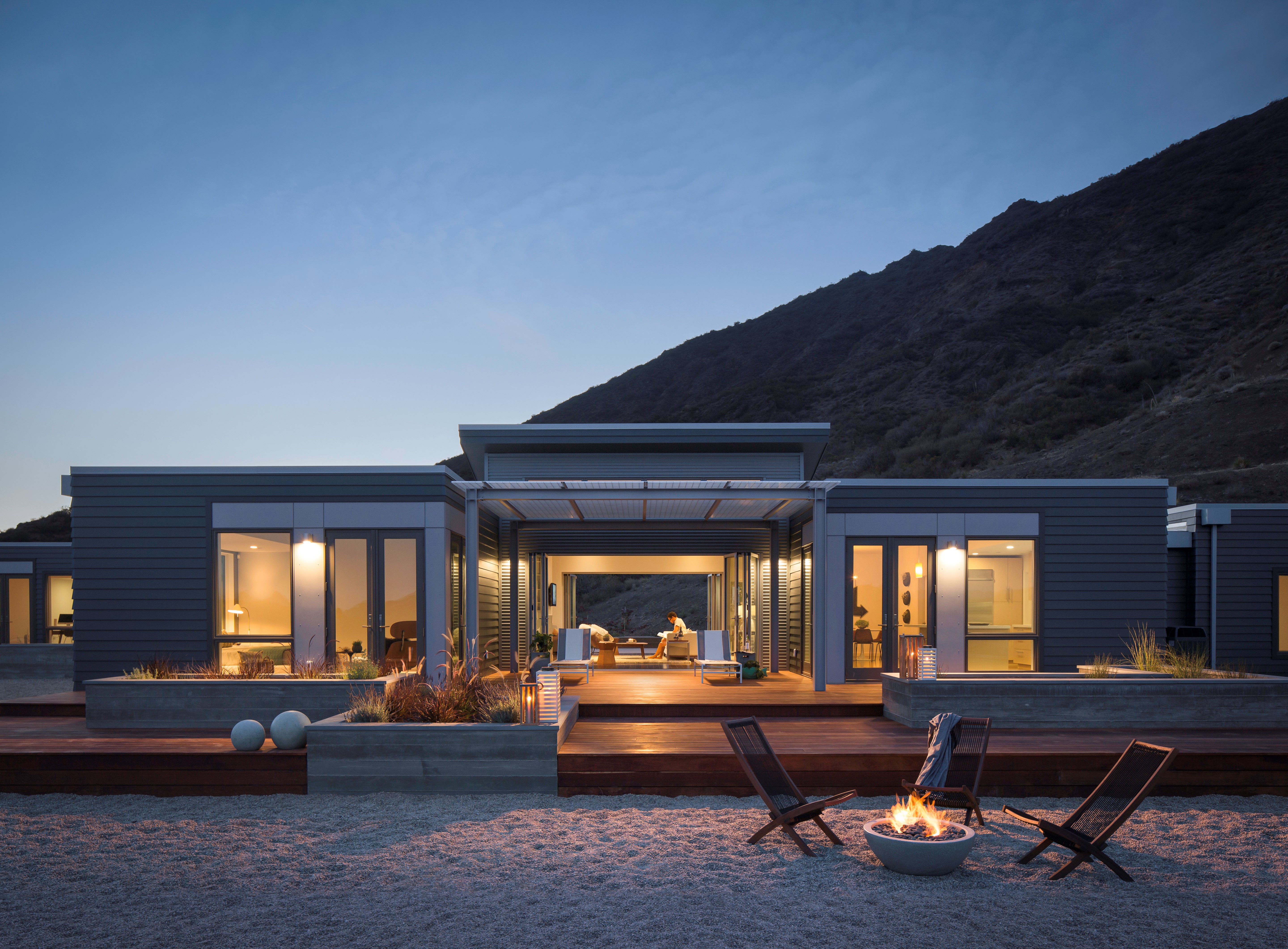Building a house is quicker and easier now, thanks to a modern approach to pre-fabricated homes.
The conventional way of building a house is inefficient. Homeowners no longer have to deal with the truckloads of wood, drywall, and concrete delivered to a house site, sorting it all, building the house, then carrying away all the scrap. It takes less time and materials to work with components that were built in places designed for that purpose. Two bonuses: quality can increase because the builders have a better place to work; and materials are stored indoors, not out in the weather for weeks or months.
Houses designed in a Modern style are particularly well-suited for the new methods. Clean lines, new materials, and an openness to innovation allow architects and builders to work from house plans that are easily customizable. A buyer selects from some general layouts, and then works with the experts to add or remove components and explore personalizations.

Building the house still requires deliveries by truck, but instead of a pile of sticks, the house arrives more than 80 percent completed. After it is onsite, the rest of the build process is more likely to take weeks rather than the months or years familiar to conventional builds.
Prefab homes are becoming more popular world-wide, especially for people who want to have a better idea of what they’re buying before they commit their funds, and in regions that have shorter construction seasons. There’s a great benefit to know the work can get done between the thaw and before the next freeze.
There are an overwhelming number of architects, contractors, and builders to pick from. We’ve selected a few from the U. S. West Coast to provide an idea of what is happening and what is possible.
Blu Homes
Blu is emphasizing Northern California with plans to expand. They continue the legacy of Glidehouse, one of the early and best-known examples of innovations in modern prefab and Modern design. Their philosophy is to work with “open floor plans that let the outside in™”. Their design options are substantial, able to provide models from tiny houses with 438 square feet up to a mansion-esque 6,100 square feet.
Styles include multi-story, peaked or flat roof, window walls, balconies, and courtyards. The Breeze has a central room that acts as a breezeway for outdoor living when the weather’s right; that then uses NanaWalls to cover the gaps with glass, turning the space back into a regular room. Butterfly rooflines allow rows of celestory windows that pull light into the 15 foot ceilings.
Blu also developed folding technology that allows for wider and taller buildings that still fit on a truck for delivery. The house isn’t limited by truck width. It also means more of the construction happens before the components reach the site. (It also makes for some great videos of the action onsite.)

ideabox
Ideabox works out of Oregon, but their installations reach as far east at Colorado and Wyoming, and into Southern California. They work from an idea that shouldn’t be radical, but may sound it. A house should be fun. That doesn’t mean bizarre paint schemes, though there’s nothing to stop an owner from doing that. Fun means making a small space work well. It means making sure even dull things like laundries get big views, or at least big windows.
Fun’s also why they emphasize small, though not necessarily tiny, houses. Design, build, and buy just what’s needed. Extra rooms can mean extra cost to buy and extra time to clean and maintain. Several of their designs are more than 1,000 square feet, but Haven is typical at 765 square feet. When every room feels like it was included with a purpose, even small spaces feel full size.
Full size also applies to the appliances, which means no compromises and concessions necessary. If you really want tiny, though, they do have the 430 square foot mini.box.
To paraphrase their CEO, live in the essentials, experience more fun and less crazy, and don’t be boring.

Prentiss Balance Wickline
Prentiss Balance Wickline (aka PBW Architects) is based in two places: Seattle, a center for innovation; and Winthrop, a place known for its appreciation of the outdoors. They work to balance “natural and built environments” and “beauty and utility”. Their center may be in Washington State, but they’ve built projects from Alaska to Maine, into Canada, and even in Nicaragua.

Prefab is a continuum, and PBW is able to provide a variety. Some solutions are so popular that they need little customization for some clients. Sites and tastes can require increasing levels of customization, which they can handle.
Their modules can be used individually, stacked, or set in groups with independent orientations that take advantage of the site and the views. As stated, the maximum size is 2,800 square feet; but with modules and customization much more should be possible.
Customization also produces benefits. The M2 is a now a predesigned prefab that resulted from custom prefab project. Why throw away good ideas?

There are a few things prefabs have in common; especially these three. It isn’t a surprise that people who live in seismically active areas and design houses that are delivered at highway speeds tend to build strong homes. While prefab reduces much of the onsite work and waste, some of conventional steps are familiar. The site must be prepped, utilities brought in, and foundations and driveways poured. But, there are big savings in terms of finish work. Wires and plumbing are already in the walls. Windows and doors may already be installed, and fitting better because they and their frames were built in jigs.
Moving in and decorating, well, that’s customization that every customer gets to tackle at their own pace.
